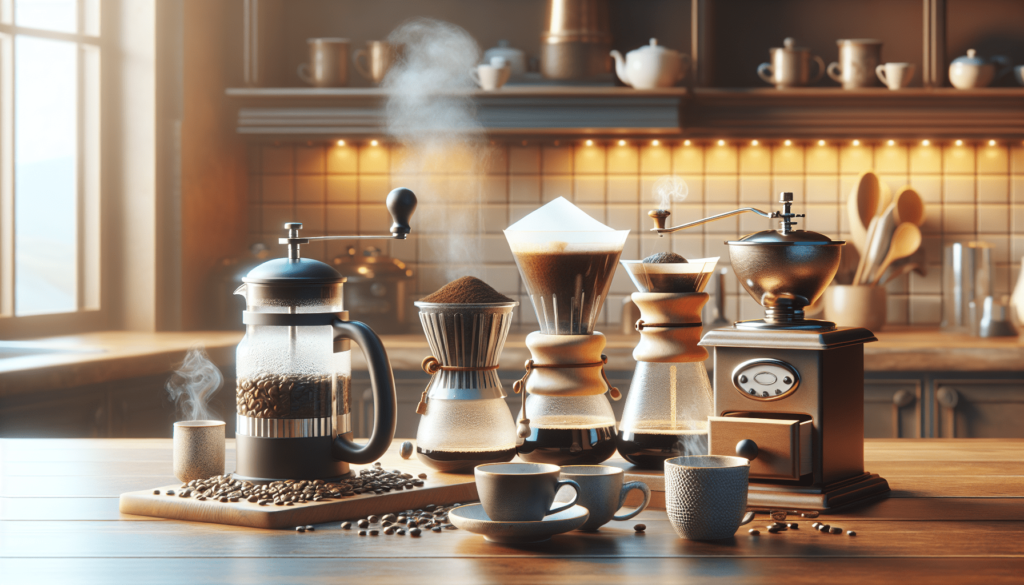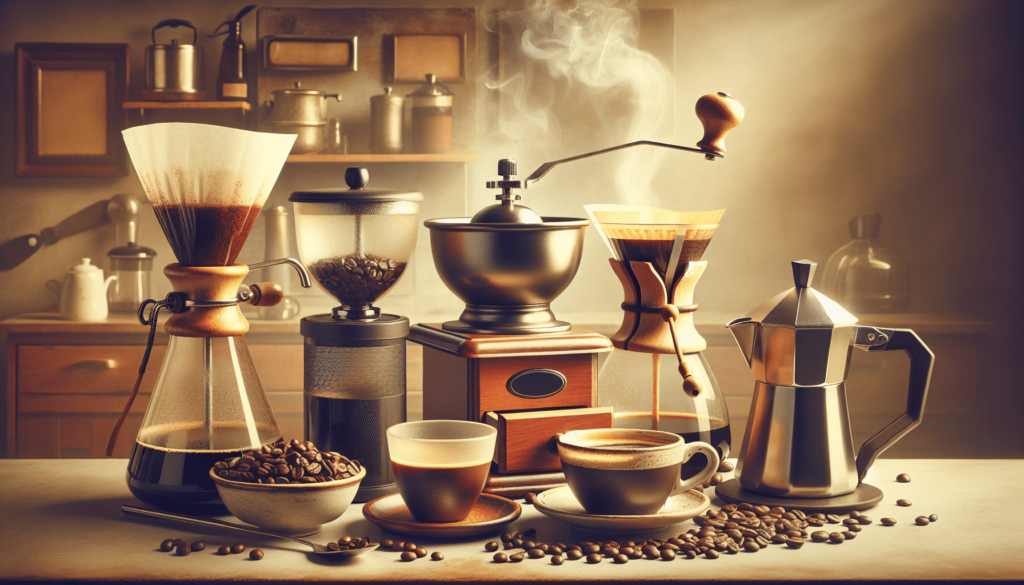Do you ever wonder what is the best brew method to truly taste and appreciate coffee? With so many brewing options available, it can be quite a journey to discern which method brings out the most nuanced flavors and aromas from your favorite beans. Coffee, much like wine, holds a complex profile that can be magnified or diminished based on how it’s brewed. Each method has its own set of rules, its own character, and its own way of unlocking the secrets within every coffee bean.
Understanding the Basics: What Influences Coffee Flavor?
Before diving into the specifics of each brewing method, it’s essential to understand the factors that influence coffee flavor. Each of these factors plays a critical role in the final taste of your coffee. Knowing them will help you better appreciate the strengths and weaknesses of different brewing methods.
Coffee Beans and Origin
The flavor profile of coffee largely depends on the type of bean and its origin. Arabica and Robusta are the two primary species, with Arabica being more nuanced and delicate, and Robusta offering a more robust, bitter flavor.
Roast Level
Roast levels range from light to dark, each affecting the flavor. Light roasts preserve the bean’s natural flavors and acidity, while darker roasts often introduce bolder, more bitter notes.
Grind Size
Grind size significantly impacts extraction. Fine grinds increase surface area, leading to a faster, more intense extraction. Coarse grinds, on the other hand, allow for a slower, more controlled extraction.
Water Quality and Temperature
Water makes up about 98% of your coffee, so its quality is crucial. Filtered, fresh water usually yields the best results. The optimal temperature for brewing coffee is between 195°F to 205°F (90°C to 96°C).
Brew Time
The duration your coffee grounds are in contact with water affects the strength and flavor of the brew. Over-extraction can make coffee bitter, while under-extraction can make it weak and sour.
Drip Coffee Makers: Convenient but Not Always the Best for Flavor
Drip coffee makers are ubiquitous in many households. They are convenient and often come with programmable features that can make your morning routine easier. But does ease of use translate to the best flavor?
Pros and Cons
| Pros | Cons |
|---|---|
| Convenient and easy to use | Limited control over brewing variables |
| Can make multiple cups at once | Often leads to over-extraction |
| Consistent results with the right setup | Flavor can be diluted due to paper filter |
Flavor Notes
Drip coffee makers often produce a more diluted cup due to paper filters, which capture some of the coffee’s oils and finer particles. While this can result in a clean cup, some of the complex flavor notes can be lost in the process.

French Press: Full-Body, Rich Flavor
The French Press, also known as a press pot or plunger pot, is a popular method that offers more control over the brewing process.
Pros and Cons
| Pros | Cons |
|---|---|
| Rich, full-bodied flavor | Requires coarse grind size |
| Preserves oils and fine particles | Sediment can be present in the final cup |
| Easy to use and clean | Manual process, time-consuming |
Flavor Notes
This method excels at producing a rich, full-bodied coffee by allowing the coffee grounds to steep in hot water. The metal mesh filter preserves the oils and small particles, resulting in a cup that’s full of flavor and texture.
Pour Over: Delicate and Complex
Pour-over methods, like the Chemex or Hario V60, have surged in popularity among coffee aficionados for their ability to highlight the subtle complexities of coffee.
Pros and Cons
| Pros | Cons |
|---|---|
| High control over brewing variables | Requires practice to perfect technique |
| Can highlight nuanced flavors and aromas | More time-consuming than automatic methods |
| Easy to adjust grind size and brew time | Requires additional equipment (paper filters, gooseneck kettle) |
Flavor Notes
The pour-over method excels in its precision. By carefully controlling the water flow and extraction time, you’re able to highlight the delicate and nuanced flavors of the coffee. This method is excellent for those who enjoy the art and science of brewing.

Espresso: Concentrated and Intense
Espresso machines use pressure to force hot water through finely-ground coffee, resulting in a concentrated shot of coffee with a rich crema on top.
Pros and Cons
| Pros | Cons |
|---|---|
| Quick brew time | Expensive equipment |
| Versatile for various coffee drinks | Requires practice to perfect technique |
| Intense, concentrated flavor | High maintenance and cleaning required |
Flavor Notes
Espresso offers a concentrated, intense experience of coffee. The high pressure and fine grind size result in a full-bodied shot that’s rich in flavor and aroma. While the equipment and technique can be more demanding, the reward is a deeply satisfying cup.
AeroPress: Innovative and Versatile
The AeroPress is a relatively new method that has quickly gained a strong following for its versatility and ease of use. It employs air pressure to push water through coffee grounds, similar to espresso but at a lower pressure.
Pros and Cons
| Pros | Cons |
|---|---|
| Fast and easy to use | Smaller brew capacity |
| Highly portable | Some learning curve for best results |
| Versatile (can mimic espresso) | Requires specific filters |
Flavor Notes
The AeroPress is capable of brewing a coffee that’s rich and clear, with less bitterness and acidity. The method allows for experimenting with different coffee-to-water ratios and brewing times, making it ideal for those who enjoy tweaking their brewing process.
Cold Brew: Smooth and Refreshing
Cold brew is made by steeping coarse coffee grounds in cold water for an extended period, usually 12 to 24 hours. This method extracts different flavor compounds than hot brewing methods.
Pros and Cons
| Pros | Cons |
|---|---|
| Smooth, low-acid flavor | Requires long brewing time (12-24 hours) |
| Can be made in large batches | Needs coarse grind size and lots of coffee |
| Versatile (can be served hot or cold) | Less complexity in flavor profile |
Flavor Notes
Cold brew produces a smooth, less acidic coffee that’s perfect for sipping on a hot day or serving over ice. While it generally lacks the complexity of hot-brewed coffee, its mellow flavor and versatility make it a popular choice.
Turkish Coffee: Traditional and Bold
Turkish coffee is a traditional method that involves simmering very finely ground coffee with water (and usually sugar) in a special pot called a cezve.
Pros and Cons
| Pros | Cons |
|---|---|
| Rich, bold flavor | Requires very fine grind size |
| Unique cultural experience | Can be gritty due to unfiltered grounds |
| Simple and quick to prepare | Requires specific equipment |
Flavor Notes
Turkish coffee offers a uniquely bold and intense flavor, often tinged with the sweetness of added sugar. The unfiltered nature of the brew allows for a thicker, richer mouthfeel, making it a unique way to savor coffee.
Comparison of Brew Methods
To better understand how these methods compare, let’s look at a summary based on key attributes like flavor, acidity, body, and ease of use.
| Method | Flavor | Acidity | Body | Ease of Use |
|---|---|---|---|---|
| Drip Coffee | Balanced | Medium | Light | High |
| French Press | Rich | Low | Full | Medium |
| Pour Over | Nuanced | High | Light | Medium-High |
| Espresso | Intense | Low | Full | Low-Medium |
| AeroPress | Versatile | Medium | Medium | High |
| Cold Brew | Smooth | Low | Medium | Medium |
| Turkish Coffee | Bold | Low | Full | Medium |
Factors to Consider When Choosing Your Brew Method
So, how do you determine the best brew method to taste coffee? It often comes down to your personal preferences and lifestyle needs. Here are some factors to consider:
Flavor Preferences
What do you like in your coffee? If you enjoy a rich, full-bodied cup, a French Press might be your best bet. If you prefer a smooth, low-acid experience, cold brew might be more your style.
Convenience
How much time and effort are you willing to invest in brewing your coffee? Drip coffee makers offer convenience and ease of use, while methods like pour-over and espresso require more attention and skill.
Equipment
Do you already have the equipment needed for your preferred method, or are you willing to invest in new tools? Espresso machines and specialty pour-over setups can be costly.
Experimentation
Are you someone who enjoys experimenting with your coffee? Methods like the AeroPress allow for a lot of tweaking and varying, while automatic drip makers are more rigid.
Conclusion: Finding the Best Method for You
In the end, the “best” brew method to taste coffee is highly subjective and depends on your personal preferences and circumstances. Each method has its own unique way of unlocking the flavors within coffee beans, making the journey to discovering your favorite brew an exciting and rewarding experience.
So, whether you opt for the richness of a French Press, the precision of a pour-over, or the convenience of a drip maker, your perfect cup of coffee awaits. Happy brewing!
